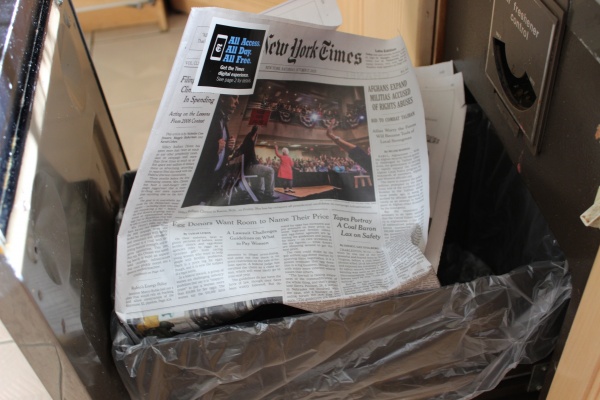Student Affairs Pushes New York Times Digital Subscriptions
The paper’s digital issue faces some issues being known about by students (ZANA NAAJJAR/THE OBSERVER)
October 22, 2015
Despite the decision made in February to offer commuting students digital access passes to the New York Times in order to replace the print editions they no longer had access to and to maintain their accessibility of the newspaper, the Office of Student Leadership and Development (OSLCD) has had to explore more ways of promoting the passes to undergraduates.
The digital access pass system was expanded due to the removal of the New York Times hardcopies from outside LL408, which was done in response to non-commuters taking the newspapers. This decision eliminated commuting students’ access to the print edition, leading OSLCD to expand digital so that the commuting students could still access the Times.
According to figures provided by Dean of Students Keith Eldredge, however, students are not using the digital access passes frequently. Last year, the passes were used on average by only 20 people a day, and peaked at 70.
“Our numbers show that we’ve come nowhere close to using up all the passes,” Eldredge said.
In order to combat this issue and to promote the digital subscriptions to commuters, Eldredge and the Commuting Students Association (CSA) have teamed up.
“The Commuting Students Association has really embraced the idea of helping us push this information to commuting students so that they know about the online passes available, and they’ve done a number of different initiatives,” Eldredge said.
“We’re trying to push the awareness of the online portion of it to commuters because we don’t have the hard-copies in an area that’s accessible to them anymore,” Eldredge said. “So resident students are certainly allowed and able to take advantage of the online access as well, we’re not restricting that in any way to any particular population, but we figure the folks that are most interested in the New York Times are going to know it’s there and are going to grab it as they come and go in the mornings each day.”
Along with these initiatives to promote the digital access to commuters are plans to provide access to the print edition to them again.
“The executive board of the Commuting Students Association approached me late in the spring, and I had some conversations with them over the summer, and we’ve just about finalized a plan,” Eldredge said. “They’re going to take a small quantity of newspapers, maybe 10 to start with, and have them available in the CSA office during their hours as way to say ‘hey commuting students, come to our office. We want you to engage with CSA anyway, and here’s a resource if anyone’s looking for a hard-copy paper.’ If they run out of papers in five minutes every day, then we’re going to have to rethink this. On the other hand if nobody shows up and nobody wants the papers, I’ll imagine we’ll discontinue doing it.”
The Office of Student Affairs is also exploring options to make the Times available to students once the office moves to the Old Law School building once its renovations are completed, according to Eldredge.
“We’ll have to rethink a bunch of things when we get over there into that new space so that’s certainly on the docket to see if maybe there is an opportunity to do that,” Eldredge said.
Similar to OSLCD’s decision to expand the digital New York Times access pass programs is the Gabelli School of Business’ (GSB) day pass system for the Wall Street Journal available to business students.
“Business students have access to the Wall Street Journal online, and we recently, through the help of the IT department, made it easily accessible through the Gabelli Connect website,” Rev. Vincent Decola, S.J. and assistant dean of Global Business at Lincoln Center, said.
However, Gabelli continues to offer the print editions of the Wall Street Journal on the 6th floor of Lowenstein, unlike OSLCD’s offering of the New York Times.
“Anyone can stop on the 6th floor, but they’re intended to be for the business students,” DeCola said.
The oddity of the New York Times offerings to students, however, is that many continue to read the print edition, despite the expansion of the digital access passes.
“The print editions, they go,” Eldredge said. “I get that report back from [the Times] on a monthly basis, and there’s some days where there’s maybe five papers they take back the next morning, but most days it’s zero. At some point throughout the 24 hour period the newspapers are going out of the residence halls.”
Students such as Luke Momo, Fordham College at Lincoln Center (FCLC) ‘19, who regularly read the print editions of the Times provided on campus, attest to sticking with the print medium.
“Print paper gives you news in a tactile way that accessing a computer doesn’t,” Momo said. “It’s something you can take with you, hold in your hand, doesn’t run out of battery, and has a build and organized structure to it.”
Momo, however, called something else to attention as he flipped through The New York Times he had picked up on campus: “Where’s the Arts section?”
Students may have noticed the absence of the Arts section from the print editions available on campus, as well as the remainder of the third section of the paper indicated in the copies’ tables of contents.
The print editions of the New York Times are available on the 2nd floor of McMahon and in McKeon. Although the Fordham website indicates that the print editions are available on “the 1st floor of McKeon Hall outside the elevators inside the turnstile,” they are currently available in McKeon only within the Undergraduate Dining Hall.










